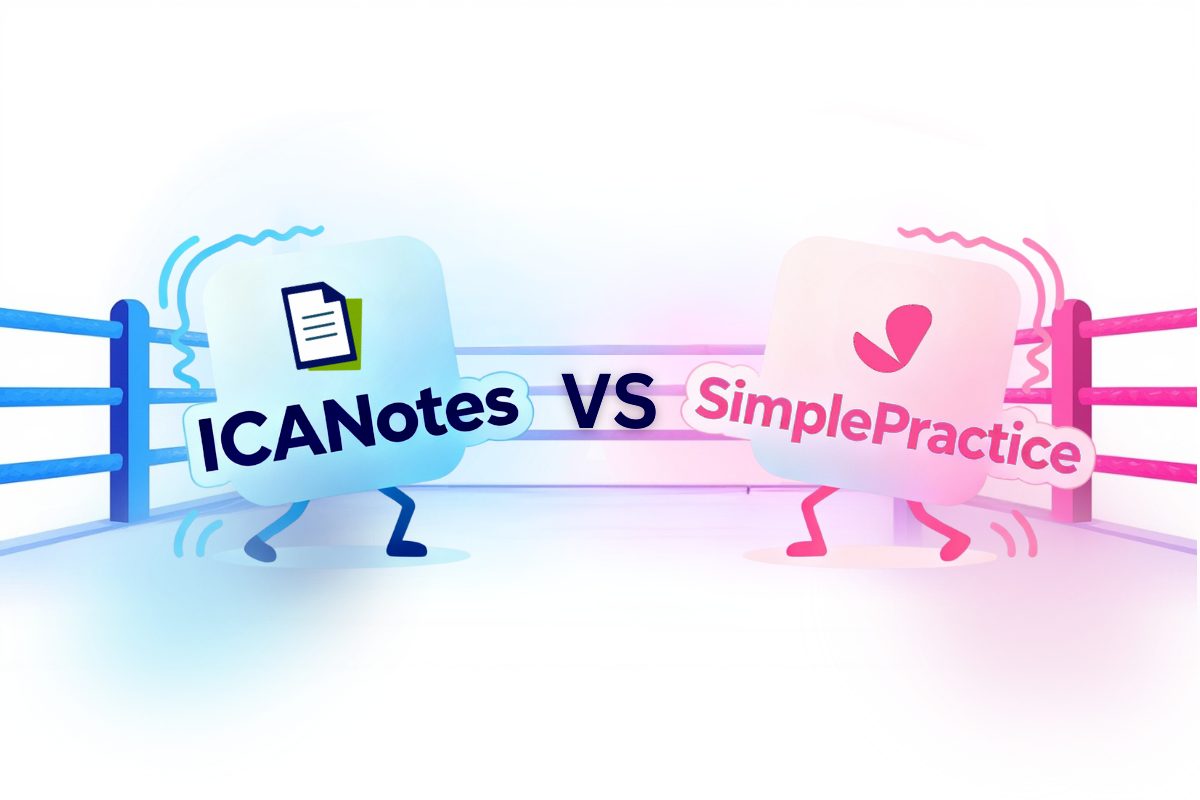Blog > Documentation > EHR vs EMR: Key Differences
EHR vs EMR: What’s the Difference?
An EMR is a digital version of a paper chart used in a single practice. An EHR includes that information but allows it to be shared across providers and care settings. For behavioral health professionals, this difference can affect how you document care, collaborate with others, and support better outcomes. In this post, you’ll learn how to choose the right system based on your workflow, team structure, and long-term goals.

Last Updated: November 5, 2025


What You'll Learn
-
The core differences between EMR and EHR systems in behavioral health settings.
-
How data sharing and interoperability affect care coordination across providers.
-
Key questions to determine which system best fits your practice's needs.
-
Why CEHRT certification matters for compliance and value-based care programs.
-
Essential EHR features specifically designed for mental health and substance use treatment.
Behavioral health often involves care teams, referrals, and coordination across services. Your system needs to support that complexity. Whether you manage a solo practice or a large organization, knowing the difference between EMR and EHR will help you pick a solution that saves time, improves care, and meets compliance requirements.
What Is an EMR?
An Electronic Medical Record (EMR) is a digital version of a patient’s paper chart used within a single healthcare practice. It captures the medical and treatment history from one provider and is primarily used for internal documentation, follow-up care, and clinical tracking.
Primary use of an EMR:
To document progress notes, diagnoses, and treatment plans within a single behavioral health practice or clinician’s workflow.

EMR Example:
A therapist in private practice uses an EMR to record session notes, manage medications, and track clinical progress over time without needing to share data externally.
An EMR typically includes:
- Diagnoses
- Clinical notes
- Medications and prescriptions
- Immunization records
- Past visit summaries
- Lab and diagnostic test results
EMRs improve documentation accuracy, reduce the need for paper records, and streamline charting. However, they are not built for secure data sharing with other organizations, which can limit collaboration with primary care providers, labs, or case managers.
What Is an EHR?
An Electronic Health Record (EHR) is a digital system that stores and shares a patient’s health information across multiple providers, organizations, and care settings. It includes all of the clinical data found in an EMR, along with tools for interoperability, compliance, and coordinated care.
Primary use of an EHR:
To support integrated care by allowing behavioral health providers to exchange patient information with external teams, labs, and healthcare systems in real time.

EHR Example:
A community mental health center uses an EHR to share patient updates with primary care physicians, receive lab results electronically, and submit data for quality reporting programs.
An EHR also includes:
- Coordination of care across multiple providers
- Integration with labs, pharmacies, and health information exchanges
- Features for ePrescribing, billing, and outcome reporting
- Patient portals and secure messaging tools
- Support for regulatory programs and value-based care
EHRs enable behavioral health providers to deliver more connected care, reduce documentation gaps, and stay compliant with evolving healthcare regulations. They make it easier to collaborate, report outcomes, and support whole-person care across different settings.
EMR vs EHR: A Side-by-Side Comparison
For behavioral health clinicians, the difference between an EMR and an EHR goes beyond terminology — it impacts how seamlessly you can document, share, and coordinate care. While an EMR focuses on internal record-keeping, an EHR like ICANotes is designed for connected, compliant, and comprehensive documentation across every aspect of client care. The comparison below highlights the distinctions that matter most when choosing the right system for your practice.
| Feature | EMR (Electronic Medical Record) | EHR (Electronic Health Record) |
|---|---|---|
| Scope | Used within a single practice or provider. | Covers a patient’s full health across providers and settings. |
| Interoperability | Limited data sharing outside the organization. | Built for sharing data with other providers, labs, and systems. |
| Data | Includes clinical history, diagnoses, and treatments from one provider. | Combines data from multiple providers, labs, and care settings. |
| Functionality | Supports internal documentation, billing, and scheduling. | Adds tools like ePrescribing, portals, HIE access, and reporting. |
| Care Coordination | Not designed for collaboration across organizations. | Enables shared access to patient records for coordinated care. |
| Compliance | May not meet federal reporting or incentive program requirements. | CEHRT-certified for regulatory compliance and quality reporting. |
| Best For | Solo providers or practices without external coordination needs. | Organizations that collaborate with other providers or need scalable, connected systems. |
Choosing Between an EHR and EMR
Not sure which system is right for your behavioral health practice? Choosing between an EHR and an EMR comes down to how your organization delivers care and how connected you need to be.
Here are a few key questions to help guide your decision:
Do you need to exchange data with outside providers, labs, or health systems?
If you regularly coordinate with primary care physicians, specialists, labs, or community support services, you’ll need a system that can securely share patient information. EHRs are designed for interoperability and seamless communication across care settings.
Are you required to report on quality measures or use Certified EHR Technology (CEHRT)?
Many value-based care models, federal programs, and payer requirements call for certified EHR systems that support electronic quality reporting, patient engagement, and population health tracking.
Do you want patients to access their records, send messages, or manage appointments online?
Patient portals and engagement tools are typically only available with an EHR. These features empower patients, improve satisfaction, and reduce administrative tasks.
Is your organization growing, scaling services, or collaborating across multiple locations or providers?
EMRs are often suitable for solo practices with limited external coordination. But as your practice expands, the ability to unify records across care teams, locations, and systems becomes critical — and that’s where EHRs excel.
If you answered yes to any of the above, an EHR is likely the better long-term solution. It provides the flexibility, compliance support, and connectivity modern behavioral health organizations need to deliver coordinated, patient-centered care.
Is ICANotes an EHR or EMR?
ICANotes serves as both an EMR and an EHR, depending on the needs of your behavioral health practice. For solo providers or smaller teams, it offers efficient internal documentation tools. For larger organizations and collaborative care environments, ICANotes delivers the interoperability and regulatory readiness of a full-featured EHR.
ICANotes as an EMR:
- Streamlined charting and note writing for individual clinicians.
- Digital recordkeeping designed for use within a single practice.
- Speciality-specific templates for psychiatry, psychotherapy, and substance use treatment.
- Fast, structured documentation that reduces admin time.
ICANotes as an EHR:
- Certified EHR Technology (CEHRT) to meet regulatory and payer requirements.
- Supports HL7, SFTP, CCD, and secure fax for seamless data exchange.
- Interfaces with labs, HIEs, pharmacies, imaging centers, and billing clearinghouses.
- Enables quality reporting and participation in value-based care programs.
- Offers a patient portal, ePrescribing, telehealth tools, and third-party integrations.
Clinicians can start with a focused documentation system and add interoperability features as their needs expand. ICANotes provides practices with the flexibility to evolve from simple charting to a fully integrated EHR that supports collaborative, coordinated care.
EHRs and Certified Technology (CEHRT)
To participate in federal programs like Medicaid Promoting Interoperability, and the Quality Payment Program (QPP), behavioral health providers must use a Certified Electronic Health Record Technology (CEHRT). This certification confirms that an EHR meets national standards for interoperability, security, and functionality set by the Office of the National Coordinator for Health IT.
CEHRT systems:
- Comply with federal requirements for secure data exchange.
- Support patient access through tools like portals and visit summaries.
- Enable electronic prescribing and clinical quality measure (eCQM) submission.
- Protect sensitive health information in accordance with HIPAA regulations.
- Provide a foundation for participating in value-based care programs.
ICANotes is a CEHRT that equips behavioral health providers with the infrastructure to stay compliant and efficient.
What to Look for in an EHR for Behavioral Health
Behavioral health providers need more than a general medical EHR. From documentation to coordination, the right system should reflect the clinical, regulatory, and workflow demands of mental health, psychiatry, therapy, and substance use care.
Look for these essential features when choosing an EHR for your practice:
- Behavioral health templates and structured documentation.
- DSM-5 and ICD-10 coding and billing support.
- Secure messaging between patients and providers.
- Medication management and ePrescribing tools.
- Compliance features for HIPAA and Joint Commission.
- Integration with labs, pharmacies, and clearinghouses.
- Support for telehealth, group therapy, and referrals.
- Reporting tools for outcomes and quality metrics.
ICANotes offers all of these capabilities on a platform built specifically for behavioral health. It provides clinicians with the structure they need, along with the flexibility to scale across various care settings.
Frequently Asked Questions
Get Started Today
The right health record system can impact everything from care coordination to compliance. ICANotes offers the flexibility of an EMR and the connectivity of an EHR, helping behavioral health providers document efficiently, share data securely, and meet reporting requirements.
Explore how ICANotes can support your team with structured notes, interoperability, and tools built for behavioral health.
Start your free trial, schedule a demo, or contact us for a custom quote.
Start Your 30-Day Free Trial
Experience the most intuitive, clinically robust EHR designed for behavioral health professionals, built to streamline documentation, improve compliance, and enhance patient care.
- Complete Notes in Minutes - Purpose-built for behavioral health charting
- Always Audit-Ready – Structured documentation that meets payer requirements
- Keep Your Schedule Full – Automated reminders reduce costly no-shows
- Engage Clients Seamlessly – Secure portal for forms, messages, and payments
- HIPAA-Compliant Telehealth built into your workflow
Complete Notes in Minutes – Purpose-built for behavioral health charting
Always Audit-Ready – Structured documentation that meets payer requirements
Keep Your Schedule Full – Automated reminders reduce costly no-shows
Engage Clients Seamlessly – Secure portal for forms, messages, and payments
HIPAA-Compliant Telehealth built into your workflow
Related Posts

Sanjiv Patel
Vice President of Product
Sanjiv Patel is Vice President of Product at ICANotes, where he leads the strategic development of behavioral health EHR and billing solutions. With over 20 years of experience in healthcare technology, Sanjiv has spearheaded major product initiatives that enhance clinical efficiency and provider outcomes. He holds CSM and CSPO certifications and is a graduate of Drexel University.










